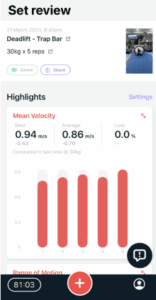Velocity-Based Training: Enhancing Strength & Power

Claire Small
Chief Clinical Officer & Consultant Physiotherapist
- 3 May, 2023
- Exercise
- 3 min read
Velocity Based Training is a method of resistance training with the aim of improving strength and power. Although instead of tracking how much weight you can move, we track how fast the weight moves.

Why and when would you use this?
1. Power Development
Velocity Based Training is best applied to people who have developed some strength and now aim to improve muscular power to help them jump, hop, accelerate, decelerate, and change direction. For example:
A 29-year-old female netball player with a meniscus repair who, through physiotherapy, has regained range of motion and function in her knee, no longer has pain and has undergone hypertrophy training (increase and growth of muscle cells) to re-develop her muscle mass. Her knee is strong on isometric testing, and she is ready for the next phase of programming with the aim of getting back to her weekly netball competition, which requires a lot of acceleration and deceleration, change of direction, and jumping and landing. Incorporating Velocity Based Training to drive effort, intent, and tempo on 1 or 2 main lifts would be a beneficial application.
2. Submaximal Strength Testing
In my experience, many people are apprehensive about maximal strength testing – that is, testing to failure. In many cases, that’s fair enough. The ForceDecks are a great tool to be able to measure isometric strength, rate of force development and a range of other metrics without using traditional strength training methods. Velocity Based Training offers an alternative solution, too. We’re able to test people dynamically in specific lifts that they may be looking to improve, in a multi-joint movement pattern rather than isolating one limb or one joint, meaning that metrics such as a Force-Velocity Profile and Linear Regressions used to estimate 1RM can be established.
3. Track Velocity Loss
After a strenuous set of training for strength and power, it would be reasonable to lose some bar speed towards the end of the set. Velocity Based Training optimises training outcomes by tracking how much bar speed is lost.
Research tells us that any repetitions performed after a 20% loss in maximum velocity no longer deliver us the desired strength and power stimulus that we’re after, and therefore, it’s best to cut the set there. In fact, a study compared two groups on the same training program, although Group A cut their sets at 20% velocity loss while Group B stopped at 40%. (1) They found that even though Group B did more work (a lot more work), Group A smashed them in several indicators of strength and power (see graph below).
However, if the goal is to increase muscle hypertrophy, training to a greater velocity loss can be very effective. Training to 30-35% of bar speed loss is strongly correlated to improvements in muscle size.
4. Identify Readiness to Train
Finally, one of the best uses of Velocity Based Training is detecting when a person comes into a session a little off, and we can modify their training accordingly. For example:
A 40-year-old man attends a session and performs his Trap Bar Squat (80 kgs) at a sluggish 0.45 m/s at maximum velocity. His typical bar speed is up around 0.75 m/s. This initiates a conversation about his mood, pain, energy, sleep, hydration, and any other psychosocial factors which might be influencing this drop in performance. His training can now be tailored further to suit his condition on the day of the session.
I know what you’re thinking, ‘can’t reps-in-reserve (RPE) do this for us?’ Yes, of course it can, but RPE is subjective and is often reported poorly. Velocity Based Training is objective, accurate, and the numbers are clear and accurate.
How is this practically useful?
Velocity Based Training has typically been only possible with expensive equipment; however, a leading Australian strength coach teamed up with a software engineer to develop a free iOS app which can track Velocity Based Training through the device’s camera.
Watch a video demonstration here:
And here is an example of what the metrics look like:

In conclusion, Velocity Based Training is a great supportive adjunct to strength training programmes, allowing us to be more focused and direct training so it is more accurate and offers better results.
If you have strength and power related goals and would like to try Velocity Based Training, or if you’d like to know more about it, get in touch today by completing the form below.
References
- Pareja‐Blanco, F. et al. (2017). Effects of velocity loss during resistance training on athletic performance, strength gains and muscle adaptations. Scandinavian journal of medicine & science in sports, 27(7), 724-735.
- VBT Coach (2021). Velocity loss & fatigue guidelines with velocity-based training, <https://www.vbtcoach.com/blog/velocity-loss-guidelines-for-fatigue-with-velocity-based-training> [Accessed on 22 Mar 2023].
- Core Advantage Pty Ltd. Metric VBT (version 1.3.1). [Mobile app downloaded from iTunes App Store]. [Accessed 22 Mar 2023].

Advice
Over the last 20+ years our experts have helped more than 100,000 patients, but we don’t stop there. We also like to share our knowledge and insight to help people lead healthier lives, and here you will find our extensive library of advice on a variety of topics to help you do the same.
OUR ADVICE HUBS See all Advice Hubs

